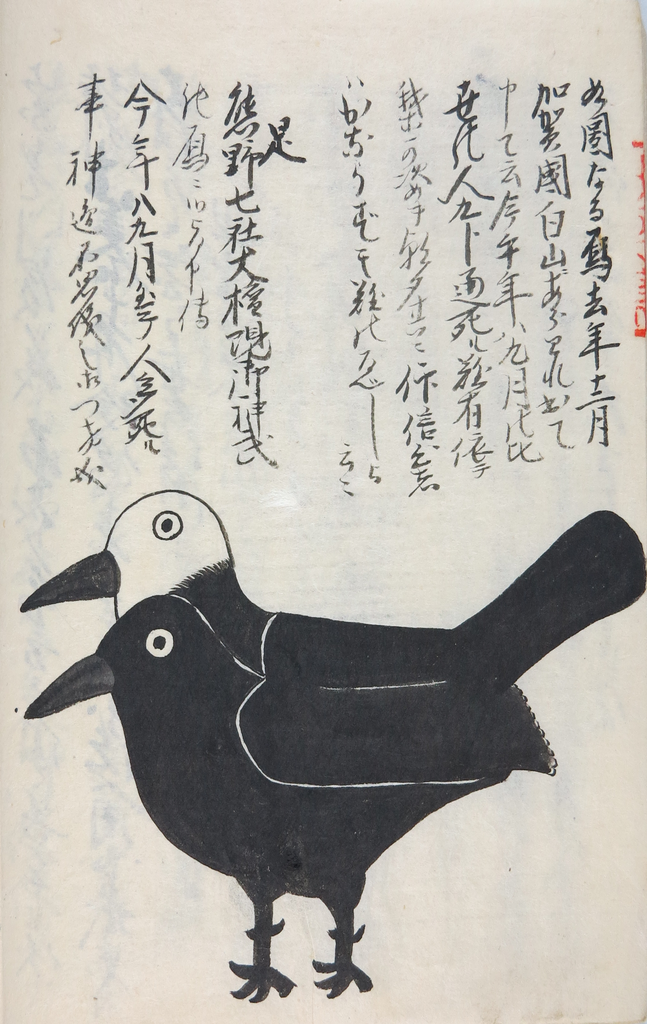[Top Image] "Yogen no Tori," or the Prophet Bird, from a journal documenting the cholera pandemic of mid-19th century Japan. Courtesy of Yamanashi Prefectural Museum.
Japan is a country rich with many whimsical characters and mascots. This is not just a modern phenomenon. Since ancient times, the country has nurtured fairy tales and a folklore full of eccentric creatures, spirits or "yokai" which often appear as oracles or assist humans at difficult times. In the midst of the current pandemic, it is no surprise that a whole gang of "yokai" or spirits with pandemic-related superpower have emerged back into the limelight. The most celebrated of them is Amabie. A 1846 woodblock newspaper shows a report of a three-legged mermaid appearing offshore of Kyushu, calling itself "Amabie." Witnesses were told that the people would enjoy an abundant harvest for six years while suffering from a pandemic. The mermaid instructed them to draw an image of her and show the drawing to the people to save them from the pandemic.

A 1846 tabloid reports the appearance of Amabie with its whimsical drawing.
Another one is "Yogen no Tori" or The Prophet Bird. It is from "Boushabyou Ryuko Nikki," or A Diary of the Cholera Pandemic by a local headsman called Kisaburo from Kai Province (the current Yamanashi prefecture). Kisaburo describes the horrifying spread of cholera in 1858, and how people and local governments tried to prevent it. In an early August log, Kisaburo wrote about how a two-headed bird showed up in Kaga province (current Ishikawa prefecture) in the previous December and predicted the death of 90% of the population next summer. In order to survive, the bird told people to pray to its reproduced image. Yamanashi Prefectural Museum, the owner of the diary, named the mysterious bird "Yogen no Tori" and tweeted its image in April 2020. It quickly went viral and the museum now offers a high resolution image of the illustration on their website and encourages people to recreate it.

The cover of A Diary of Cholera Pandemic.
Praying for gods and spirits was the best measure to take for saving people from the pandemic. However there was, in fact, a Dr. Fauci-like figure in early nineteen century Japan who advocated a scientific approach. His name was Hashimoto Hakuju, from Yamanashi Prefecture. After studying western medical theories, Dr. Hashimoto discovered the basic mechanics of infectious disease through his own research and practices. Long before the discovery of viruses, he theorized that some diseases were caused by tangible poisons, contaminated through food, direct and in-direct contact, and sharing the same space. His book "Dandokuron" (Treaties on Eliminating Poisons) published in 1810 was the first book in Japan to introduce modern ideas of infectious disease. It encouraged staying home in isolation during the pandemic. The book warns to avoid festivals, theaters, or any gatherings, and suggests that relatives be told not to send gifts. If they do anyway then throw items away in to the water. He also had ideas about immunity and encouraged recovered patients to engage in taking care of new patients. Many of Hashimoto's guidelines would probably be agreed to today by Dr. Fauci. Unfortunately though, he was too far ahead of his time. His guidelines were never been regulated by the government despite his tireless efforts. His achievements and publications were long forgotten in Japan's medical history, until 2020 when they were reintroduced by historians in this new pandemic.

The cover of Treaties on Eliminating Poisons by Hashimoto Hakuju


